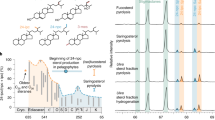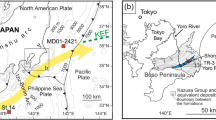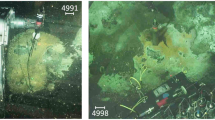Abstract
BECAUSE of their chemical stability, alkanes and fatty acids have been widely used as indicators of biological origin in studies of sediments1–4, but their formation may often be attributable to abiogenic syntheses and transformations5 so that their distribution patterns should be approached with caution. Little effort has been expended on analysis of sediments for relatively unaltered molecules which are biologically more significant, such as sterols which are present in sea water6, bottom muds (both marine and non-marine)7,8, surface soils9, and an Eocene shale10. If such molecules are present in sediments representing a wide period of geological time, their significance with regard to depositional environment and contributory organisms would exceed any other biological marker in common use. We report some organic geochemical studies of a Pleistocene basin and a contemporary lake where we are attempting to correlate alkane, fatty acid, steroid, amino-acid and sugar distribution patterns with stratigraphy and biological environment.
This is a preview of subscription content, access via your institution
Access options
Subscribe to this journal
Receive 51 print issues and online access
$199.00 per year
only $3.90 per issue
Buy this article
- Purchase on Springer Link
- Instant access to full article PDF
Prices may be subject to local taxes which are calculated during checkout
Similar content being viewed by others

References
Eglinton, G., in Advances in Organic Geochemistry (edit. by Schenck, P. A., and Havenaar, I.), 1 (Pergamon Press, Oxford, 1968).
Blumer, M., and Cooper, W. J., Science, 158, 1463 (1967).
Oró, J., Nooner, D. W., Zlatkis, A., Wikström, S. A., and Barghoorn, E. S., Science, 148, 77 (1965).
Henderson, W., Wollrab, V., and Eglinton, D., in Advances in Organic Geochemistry (edit. by Schenck, P. A., and Havenaar, I.), 181 (Pergamon Press, Oxford, 1968).
Studier, M. H., Hayatsu, R., and Anders, E., Geochim. Cosmochim. Acta, 32, 151 (1968).
Matthews, W. S., and Smith, L. L., Lipids, 3, 239 (1968).
Schwendinger, R. B., and Erdman, J. G., Science, 144, 1575 (1964).
Attaway, D., and Parker, P. L., Science, 169, 674 (1970).
Meinschein, W. G., and Kenny, G. S., Anal. Chem., 29, 1153 (1957).
Mattern, G., Albrecht, P., and Ourisson, G., Chem. Commun., 1570 (1970).
Gilbert, C. M., Christensen, M. N., Al-Rawi, Y., and Lajoie, K. R., in Studies in Volcanology (edit. by Coats, R. R., Hay, R. L., and Anderson, C. A.), Memoir 116 (Geological Society of America, 1968).
Lajoie, K. R., thesis, Univ. California, Berkeley (1968).
McCarthy, R. D., and Duthie, A. H., J. Lipid Res., 3, 117 (1962).
Reitz, R. C., and Hamilton, J. G., Biochem. Physiol., 25, 401 (1968).
de Souza, N. J., and Nes, W. R., Science, 162, 363 (1968).
Ikekawa, N., Morisaki, N., Tsuda, K., and Yoshida, T., Steroids, 12, 41 (1968).
Author information
Authors and Affiliations
Rights and permissions
About this article
Cite this article
HENDERSON, W., REED, W., STEEL, G. et al. Isolation and Identification of Sterols from a Pleistocene Sediment. Nature 231, 308–310 (1971). https://doi.org/10.1038/231308a0
Received:
Issue Date:
DOI: https://doi.org/10.1038/231308a0
This article is cited by
-
An interferometric investigation of emission lines from the solar corona
Solar Physics (1973)
-
Isolation and Characterization of Stanols from the Green River Shale
Nature (1972)
Comments
By submitting a comment you agree to abide by our Terms and Community Guidelines. If you find something abusive or that does not comply with our terms or guidelines please flag it as inappropriate.


